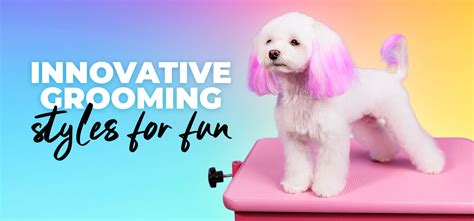Introduction
In the realm of pet care, dog grooming has emerged as an essential aspect of canine health and well-being. With the increasing popularity of dogs as companion animals, owners are becoming more discerning in their grooming choices, seeking styles that enhance their pets’ appearance, comfort, and overall health. This article delves into the latest dog grooming trends, exploring the nuances of various styles and their impact on canine well-being.

Traditional Grooming Styles
Classic grooming styles have stood the test of time, offering timeless elegance and functionality for dogs of all breeds.
1. The Basic Trim
Also known as the “natural cut,” this style involves trimming the fur short and even, leaving a neat and tidy appearance. It is suitable for dogs with short to medium coats, providing practicality and ease of maintenance.
2. The Kennel Cut
Originally intended for show dogs, the kennel cut features a short, close trim over the entire body, except for the head and tail. This style provides a clean, hygienic appearance and is preferred by many dog owners for its low-maintenance upkeep.
Creative Grooming Styles
Modern grooming techniques have introduced a world of creative possibilities, allowing owners to express their individuality and their dogs’ unique personalities.
1. The Teddy Bear Cut
Inspired by the adorable teddy bear, this style transforms dogs into cuddly companions. The fur is trimmed into a rounded shape, with the face and paws resembling a teddy bear’s features. It is ideal for dogs with soft, plush coats.
2. The Lion Cut
This dramatic style mimics the mane of a lion, creating a striking silhouette. The fur is trimmed short on the body, while the mane and tail are left long and flowing. It is best suited for breeds with thick, luxurious coats.
Tailored Grooming Styles
Tailored grooming styles focus on personalizing the groom to suit the individual needs of each dog, taking into account breed, coat type, and lifestyle.
1. The Breed-Specific Cut
This style is designed to enhance the natural characteristics of a specific dog breed. It follows breed standards, ensuring that the dog’s appearance aligns with its intended purpose and conforms to show ring regulations.
2. The Customized Cut
For owners seeking a truly unique look, the customized cut allows them to collaborate with groomers to create a style tailored to their preferences. This style can incorporate elements from various traditional and creative styles, resulting in a one-of-a-kind appearance.
The Evolution of Grooming Styles
Dog grooming styles have evolved over time, reflecting changes in societal preferences, canine health research, and technological advancements.
1. The Trend Towards Versatility
Grooming styles have become increasingly versatile, catering to the diverse needs of different dog breeds and lifestyles. Owners now seek styles that are both aesthetically pleasing and practical for their pets’ daily activities.
2. The Rise of Health-Conscious Grooming
Grooming techniques have been refined to prioritize canine health and well-being. Emphasis is placed on proper brushing, bathing, and nail care to minimize skin irritation, prevent infections, and maintain overall hygiene.
Choosing the Right Style for Your Dog
Selecting the appropriate grooming style for your dog depends on several factors:
1. Breed and Coat Type
Consider the specific breed of your dog and its coat type. Some styles suit certain breeds better than others, enhancing their natural features or accommodating their grooming needs.
2. Lifestyle and Activity Level
Your dog’s lifestyle and activity level should influence your grooming choices. Active dogs may require shorter cuts for comfort and practicality, while show dogs may need more elaborate styles to meet breed standards.
3. Personal Preferences
Ultimately, the choice of grooming style should reflect your personal preferences. Consider both the aesthetic appeal and the practicality of the style to ensure it aligns with your expectations and your dog’s needs.
Why Dog Grooming Matters
Regular dog grooming provides numerous benefits for both the pet and the owner:
1. Improved Hygiene
Grooming removes dirt, loose hair, and debris, preventing skin irritation and infections. It also helps distribute natural oils throughout the coat, keeping it healthy and lustrous.
2. Enhanced Comfort
Trimming overgrown fur reduces tangles and mats, allowing dogs to move freely and comfortably. Proper nail care prevents discomfort and potential injuries.
3. Health Monitoring
During grooming, owners can inspect their dogs for lumps, bumps, or other abnormalities, allowing for early detection of potential health issues.
4. Strengthening the Bond
Grooming is an opportunity for owners and their dogs to bond, providing a relaxing and enjoyable experience. It fosters trust and strengthens the bond between pet and owner.
Conclusion
Dog grooming has become an integral aspect of canine care, offering a wide range of styles to suit different breeds, lifestyles, and personal preferences. By choosing the right style and maintaining regular grooming practices, owners can enhance their dogs’ health, comfort, and overall well-being. As grooming techniques continue to evolve, we can expect innovative and creative styles to emerge, further enhancing the bond between humans and their beloved canine companions.





















